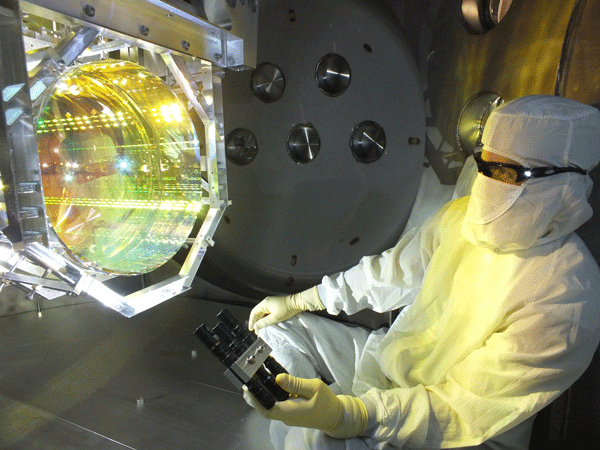Landmark gravitational waves breakthrough welcomed in China
By CHENG YINGQI (China Daily) Updated: 2016-02-13 02:45
 |
|
A technician inspects one of the US laboratory's core optics (mirrors) by illuminating its surface at different angles. Caltech/MIT/LIGO Lab |
News that elusive gravitational waves — tiny ripples in the fabric of space-time caused by violent astronomical events — have been observed for the first time has been hailed in China.
The discovery, made by the advanced Laser Interferometer Gravitational-wave Observatory in the US, confirms the last outstanding prediction made in Albert Einstein's General Theory of Relativity.
After months of speculation, scientists from the Advanced LIGO project confirmed they had detected gravitational waves caused by two black holes merging about 1.3 billion years ago.
Wang Junjie, an astrophysicist at the National Astronomical Observatories affiliated to the Chinese Academy of Sciences, said, "Besides the direct observation of the gravitational waves, the discovery has another two exciting aspects.
"Both the two black holes observed in this event are way larger than any stellar-mass black holes that have been observed. And it is the first time that astrophysicists have observed a pair of black holes orbiting around each other."
Gou Lijun, an expert specializing in black hole research for the observatories, said, "The surprise I got from this news was like a deaf person who was always envious of those who could hear suddenly finding that they could hear themselves.
"The direct detection of gravitational waves opens a new window for us to understand the world of physics. Even though the information provided by the US observatory is limited, there are amazing discoveries waiting to be made," Gou added.
According to Einstein's prediction in 1915, the universe is like an immense trampoline with countless celestial bodies stretching its surface — the heavier a celestial body is, the larger the ripples — which physicists call gravitational waves — it makes.
- China on blue alert for strong cold front
- HK chief executive condemns riot, supports police to restore order
- Hong Kong overnight riot injures at least 48 police officers
- Special troops to help keep China-Pakistan corridor safe
- New policies to aid Belt and Road business ventures
- Zika curbs to include mosquito mass extermination
- Xi visits old revolutionary base areas ahead of Spring Festival
- Nation in bid to ward off the Zika virus
- Li drops in for a chat at historic mosque
- Prison time reduced after 11 show they regret crimes







